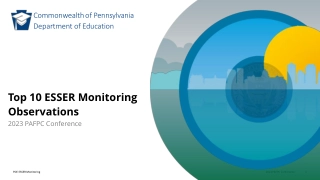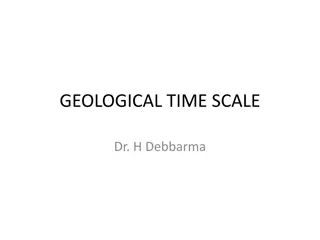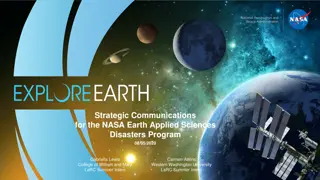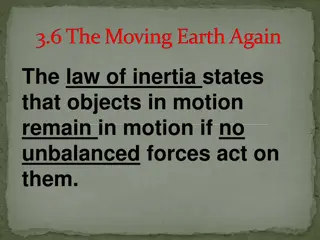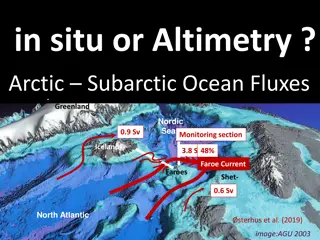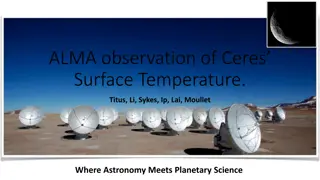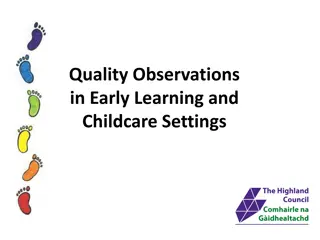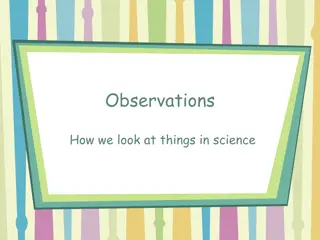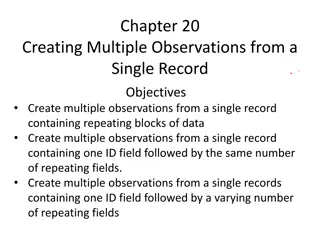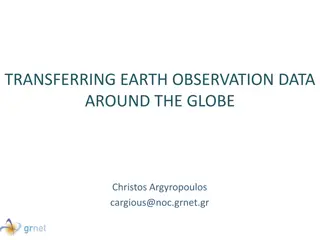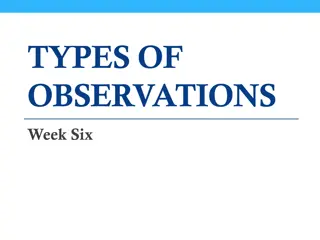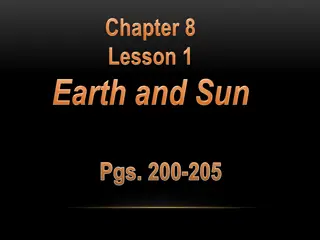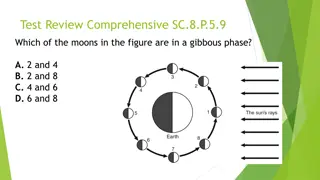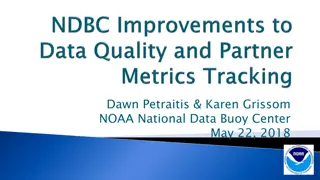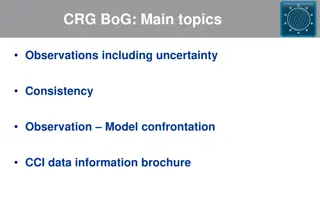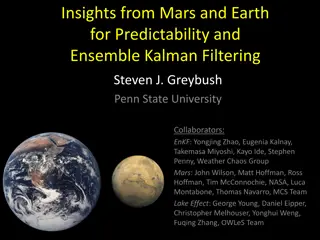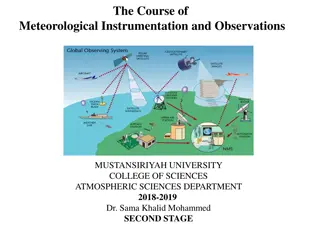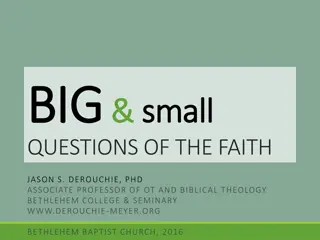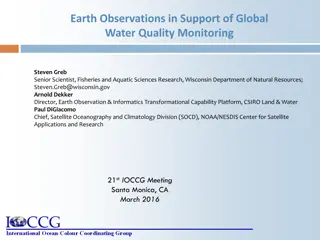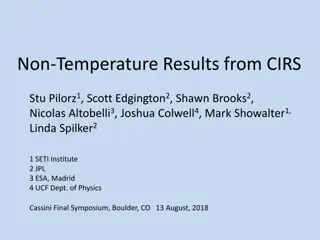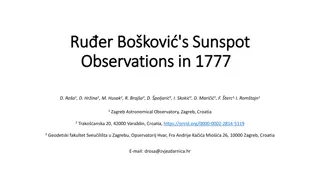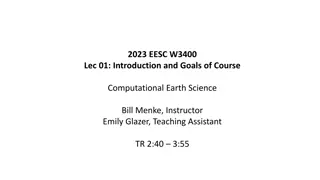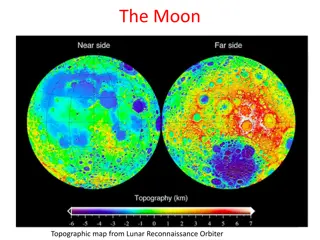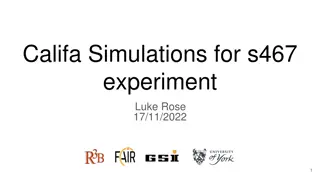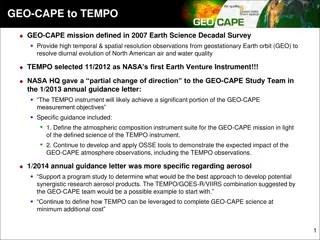Status of Activities Supporting the Space Weather Observations (SWO) Office
The status of activities supporting the Space Weather Observations (SWO) office, including implementation aspects and programs. It also emphasizes the importance of space weather information in various industry sectors and the need for planning follow-on missions for continued observations.
7 views • 26 slides
SINGLE DISCONNECTING LINK EARTH BAR
Nexus Metal & Alloys is one of the leading manufacturers, exporters, and suppliers of world-class Copper Single Disconnecting Link Earth Bar, Six Way Earth Bar with Single Disconnecting Link, Copper Single Disconnecting Earth Bar at very cheap rate from Mumbai, Maharashtra, India.
4 views • 4 slides
SOLID COPPER EARTH ROD
Nexus Metal & Alloys is a leading manufacturer, exporter and supplier of Solid Copper Earth Rod, Solid Copper Bonded Rod, Solid Copper Earth Rod Lightning Protection Accessories, Pure Copper Bonded Rod, Electrolytic Copper Earth Rod, Solid copper rods, Solid Copper Earth Bars, Solid copper ground el
4 views • 3 slides
Understanding ESSER Monitoring Observations in Pennsylvania Education
Explore the top 10 ESSER monitoring observations from the Commonwealth of Pennsylvania Department of Education. Learn about the structure, content, facilitators, and key areas of review involved in assessing educational programs. Gain insight into how observations play a crucial role in ensuring com
1 views • 42 slides
Evaluation of SPLASH and HRRR Soil Moisture Comparison
This study compares soil moisture data between the HRRR model and SPLASH observations during the 2022 warm season. It explores differences in soil moisture levels at various depths, evaluates responses to precipitation events, and drydown periods. The research focuses on analyzed data from HRRR Mode
3 views • 12 slides
Science Week at a Glance: Water in Earth's Processes
This week in Science class, students will focus on the significant role of water in Earth's processes, specifically exploring where water is located on Earth's surface and understanding the various stages of the water cycle. Each day will involve activities, discussions, and investigations related t
7 views • 13 slides
Understanding Earth's Interior through Seismic Waves: Part 1
Seismic waves provide crucial evidence about Earth's composition and structure. By analyzing the behavior of primary, secondary, and surface waves, scientists can determine the different layers and materials within the Earth. Primary waves travel through both solid and liquid parts, while secondary
9 views • 10 slides
Science Week at a Glance: Water in Earth's Processes
Explore a week focused on water in Earth's processes, covering topics such as the water cycle and the role of the sun's energy. Activities include investigations, understanding the significance of water in Earth's processes, and locating water on Earth's surface. Engage in creating water cycle puzzl
7 views • 15 slides
Understanding the Geological Time Scale and Earth's Evolution
Studying the geological time scale is crucial for comprehending Earth's history, evolution of life, and significant events that shaped our planet. Evidences like field observations, fossil records, and radioactive dating contribute to constructing this vast timeline. Major occurrences such as mass e
1 views • 46 slides
Insights into Biogeochemical Cycles and Evolutionary History of Earth
The Earth's elemental composition has remained constant over its 4.5 billion-year history, with biogeochemical cycles playing a vital role in shaping the atmosphere and oceans. The evolution of oxygen, ozone, and life on Earth is intricately linked to these cycles. Contrasting Earth and Venus, it's
0 views • 15 slides
Strategic Communications for NASA Earth Applied Sciences Disasters Program
NASA's Earth Applied Sciences Disasters Program aims to enhance disaster prediction, preparedness, response, and recovery through Earth observations. The program utilizes strategic communications to raise awareness about disaster impacts and the importance of NASA's work. It emphasizes the role of h
1 views • 14 slides
Understanding Inertia and Motion in the Moving Earth
Inertia and motion in a moving Earth debunk the argument against Earth's movement using examples of birds catching worms on trees and flipping coins in moving vehicles. Objects on Earth move with Earth's motion, showcasing the principle of inertia in action.
2 views • 7 slides
Understanding and Addressing Instability in Particle Accelerators
In this document, E. Shaposhnikova from CERN discusses observations and cures for instability in particle accelerators. The content covers types of instabilities, observations like direct and indirect effects, and possible cures such as modifying the source, passive and active damping, and changing
2 views • 30 slides
Monitoring Faroe Current Transport with Satellite Altimetry and In-situ Observations
Combining satellite altimetry and in-situ observations offers a comprehensive approach to monitoring volume, heat, and salt transports in the Faroe Current. The study focuses on the representativeness of ocean observations in the Arctic and Subarctic regions, highlighting the importance of combining
0 views • 11 slides
Sensitivity of Ocean Sampling for Coupled COAMPS-TC Prediction Study
This study explores the optimal ocean sampling strategy for Hurricane Isaac (2012) using high-resolution in-situ observations. It investigates the sensitivity of tropical cyclone intensity change through assimilation of AXBT, AXCTD, and AXCP observations. Results show significant impact areas along
0 views • 12 slides
ALMA Observation of Ceres Surface Temperature
ALMA conducted ground-based observations of Ceres' surface temperature providing valuable insights for planetary science. The data processing steps involved models interpolation, radio calibration, and thermal gradient correction to produce thermal flux maps. Key objectives included detecting the ed
0 views • 9 slides
Insights into Quality Observations in Early Learning and Childcare Settings
Explore the importance of quality observations in early learning and childcare settings to monitor children's progress and learning. Discover why, what, and how observations are made, along with the criteria for recording and evidencing progress. Learn about different types of observations and why p
0 views • 40 slides
Understanding Observations in Science
Observations in science are essential for gathering data and drawing conclusions. This includes making qualitative and quantitative observations, using senses and tools to increase accuracy, and distinguishing facts from opinions. Inferences are conclusions drawn based on observations and data. Prac
0 views • 13 slides
Creating Multiple Observations from a Single Record in SAS
Learn how to create multiple observations from a single record in SAS using line-holding specifiers like trailing @ and double trailing @@. Explore scenarios where observations are derived from repeating blocks of data or a varying number of fields following an ID. Enhance your data processing skill
0 views • 24 slides
European Union's Copernicus Programme: Eyes on Earth
Copernicus is the European Union's Earth Observation Programme that provides crucial information services through satellite data and in situ observations. The program includes various satellites like Sentinel-1 for all-weather radar imaging, Sentinel-2 for multispectral optical observations, Sentine
0 views • 37 slides
Understanding Types of Observations in Child Development
Explore different types of observations such as anecdotal records, running records, time sampling, and more used in assessing children's behaviors and learning progress. Learn about detailed narrative observations and their importance in analyzing interactions and skill acquisition. Dive into exampl
0 views • 41 slides
Fundamental Concepts of Geomorphology: Exploring Earth Forms and Evolution
Geomorphology, derived from Greek roots for earth and study, focuses on the origin and evolution of Earth's surface features. Geomorphologists study landforms above sea level and the interface between solid Earth, Hydrosphere, atmosphere, and Lithosphere. The fundamental concepts of geomorphology in
0 views • 12 slides
Understanding Day, Night, and Seasons on Earth
Earth's rotation on its axis causes day and night, with the Sun appearing to rise in the east and set in the west. The movement of stars, Moon, and planets across the sky each night is due to Earth's rotation as shadows change in length throughout the day. Seasons result from Earth's revolution arou
0 views • 20 slides
Moon Phases, Observations, and Earth's Tilt Study
Explore questions on moon phases, lunar observations, and Earth's tilt in this comprehensive science review. Answer inquiries on lunar phases, moon appearances, and the Earth's position. Engage in activities to predict moon phases, identify specific moon appearances, and comprehend the relationship
0 views • 19 slides
Implications of Star Formation in the Central Parsec of Our Galaxy with Subaru Observations
Researchers presented implications of star formation in the central parsec of our Galaxy using Subaru observations at the 2014 Subaru Users Meeting. The study focused on the supermassive black hole Sgr A* and the challenges posed by conditions in the Galactic Center for star formation. Various scena
0 views • 30 slides
Understanding the Scientific Method and Its Application in Science
Science, derived from the Latin word for knowledge, is a blend of reasoning and factual information. It hinges on observation, experimentation, and the quest for natural explanations. There are no absolute truths in science; our comprehension of nature stems from observation. Two primary scientific
0 views • 27 slides
Enhancing Data Quality: NDBC's Improvement Project
NDBC is undertaking a project to overhaul its quality control processes, algorithms, and station setups to align with technological advancements and support increased observations. The project aims to produce, disseminate, and archive high-quality observations, improve consistency and transparency,
0 views • 12 slides
CRG.BoG Main Topics: Observations & Consistency in Climate Studies
This document discusses observations, data continuity, validation methods, and consistency in climate studies. It touches on using available instruments, addressing data gap issues, lack of ground-based observations, and ensuring consistency between different Essential Climate Variables (ECVs). Vari
0 views • 8 slides
Insights from Mars and Earth for Predictability with Ensemble Kalman Filtering
A collaborative effort between Penn State University and various teams explores the predictability of Martian and Earth weather phenomena using ensemble Kalman filtering. A comparison of key characteristics between Earth and Mars is provided, shedding light on their variable atmospheres and climates
0 views • 31 slides
Meteorological Instrumentation and Observations Overview
Overview of weather maps, symbols, and the weather station model used in meteorological instrumentation and observations. Explains the importance of weather charts in forecasting processes. Also introduces the FM System of Code Forms for reporting weather observations. Helpful resources for students
0 views • 42 slides
Understanding Young Earth Creationism: Biblical Perspectives on the Age of the Earth
Exploring the viewpoint of Young Earth Creationism (YEC) based on biblical arguments, this content delves into the belief that God created the earth in six 24-hour periods, making it exceptionally young by conventional scientific standards. The discussion focuses on the biblical passages and theolog
0 views • 20 slides
Comprehensive Ship-Based Ice Measurements and Observations on Sikuliaq for Sea State DRI
This collection of images showcases various ship-based ice measurements and observations conducted on the research vessel Sikuliaq for Sea State DRI. The images include aspects such as sea ice observations, snow and ice thickness measurements, evaluation of orthorectification, and new snow and ice i
0 views • 8 slides
Earth Observations for Global Water Quality Monitoring
Declining water quality is a pressing global issue, impacting ecosystems and human health. This project aims to assess current knowledge, identify new observing capabilities, and engage users to enhance water quality monitoring through Earth observations. Key milestones include completing draft prop
0 views • 25 slides
Non-Temperature Results From CIRS Research Symposium
Rings around Icy Moons are studied through detailed observations and analyses by a team of researchers from various institutions. The study focuses on the IR emissivity results, occultation observations, and beta factor analysis carried out using the CIRS instrument. The rings are noted to emit in a
0 views • 34 slides
Sunspot Observations of Ruđer Bošković in 1777
Ruđer Bošković, a renowned Croatian scientist, conducted sunspot observations in 1777 near Paris using innovative methods. This paper aims to analyze and process his observations to determine the elements of the Sun's rotation and period, providing valuable data on solar magnetic activity. Boško
0 views • 10 slides
Computational Earth Science Course Overview
Explore the world of Computational Earth Science with Bill Menke as the instructor and Emily Glazer as the teaching assistant. The course aims to help you become proficient in applying Python-based computational methods to understand dynamic Earth Science phenomena. Through modeling, you will gain i
0 views • 34 slides
The Moon: Topographic Features and Formation
The moon, with a radius 0.27 of Earth, orbits the Earth every 27.3 days and is tidally locked with one face always pointing towards Earth. It has a composition similar to Earth's rocks and likely formed from a giant impact. The moon's surface features craters and dark patches called maria, while the
0 views • 13 slides
Califa Simulations and Experimental Observations in Nuclear Physics Research
Exploring nuclear physics research through Califa simulations and experimental observations with a focus on PID gating, clustering algorithms, beam settings, and Ca isotopes chain gating. The study involves simulating events on CH2 targets, analyzing clustering effects, and observing opening angles
0 views • 10 slides
Near-UV Satellite Observations for Retrieving Aerosol Properties
Near-UV satellite observations offer a valuable method for retrieving aerosol properties, including aerosol optical depth, absorption, layer height, and surface albedo. These observations provide advantages like sensitivity to aerosol properties and negligible gas absorption interference. However, c
0 views • 16 slides
Evolution of GEO-CAPE: Leveraging TEMPO for Atmospheric Observations
The GEO-CAPE mission, defined in the Earth Science Decadal Survey of 2007, aims to provide high-resolution observations from geostationary Earth orbit to monitor North American air and water quality. NASA's TEMPO instrument, selected in November 2012, plays a crucial role in achieving GEO-CAPE's obj
0 views • 5 slides



